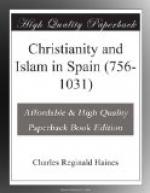[4] Cp. Paschasius: “In Christo gemina substantia, non gemina persona est, quia persona personam consumere potest, substantia vero substantiam non potest, siquidem persona res iuris est, substantia res naturae.”
[5] Blunt, ibid. Cp. also Alcuin contra Felic., iv. 5, where he says that Felix, although he shrank from asserting the dual personality of Christ, yet insisted on points which involved it.
[6] So Walchius.
The first mention of the new theory appears in a letter of Elipandus to the Abbot Fidelis, written in 783,[1] but it did not attract notice till a little later. The pope Adrian, in his letter to the orthodox bishops of Spain (785), speaks of the melancholy news of the heresy having reached him—a heresy, he remarks, never before propounded, unless by Nestorius. Together with Elipandus, he mentions Ascarius,[2] Bishop of Braga, whom Elipandus had won over to his views. The new doctrine seems to have made its way quickly over a great part of Spain,[3] while Felix propagated it with considerable success in Septimania. The champions of the orthodox party in Spain were Beatus and Etherius, whom we have mentioned above, and Theudula, Bishop of Seville; while beyond its borders Alcuin, Paulinus of Aquileia, and Agobard of Lyons, under the direction of Charles the Great and the Pope, defended the orthodox position.
[1] See Migne, 96 p. 848.
[2] Fleury, v. 236, mentions
a letter of his to Elipandus,
asking the latter’s
opinion on some doubtful points in the new
doctrine.
[3] Jonas of Orleans, in his
work against Claudius, says: “Hac
virulenta doctrina uterque
Hispaniam magna ex parte infecit.”
Felix, being bishop in a province of which Charles claimed the overlordship, was amenable to his ecclesiastical superiors, and suffered for his opinions at their hands; but Elipandus, living under a Mohammedan government, could only be reached by letters or messages. He seems even to have received something more than a mere negative support from the Arabs, if we are right in so interpreting a passage in the letter of Beatus and Etherius.[1] But it is hard to believe that Elipandus was on such friendly terms with the Arab authorities; indeed, from passages in his writings, we should infer that the opposite was rather the case.[2] Neander suggests that it may have been a Gothic king in Galicia who supported Elipandus, but this seems even more unlikely than the other supposition.
The first council called to consider this question was held by the suggestion of the Emperor and the Pope at Narbonne in 788, when the heresy was condemned by twenty-five bishops of Gaul.[3]
A similar provincial council was held by Paulinus at Friuli in 791, with the same results.[4] But in the following year the heresy was formally condemned at a full council held at Ratisbon, under the presidency of the Emperor. Here Felix abjured his error, and was sent to Rome to be further condemned by the Pope, that the whole Western Church might take action in the matter. Felix was there induced to write a book condemning his own errors, but in spite of this he was not restored to his see.[5] On his return, however, to Spain, Felix relapsed into his old heresy, which he had never really abjured.[6]




